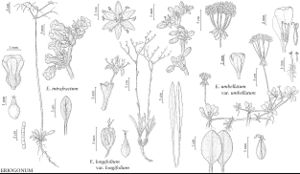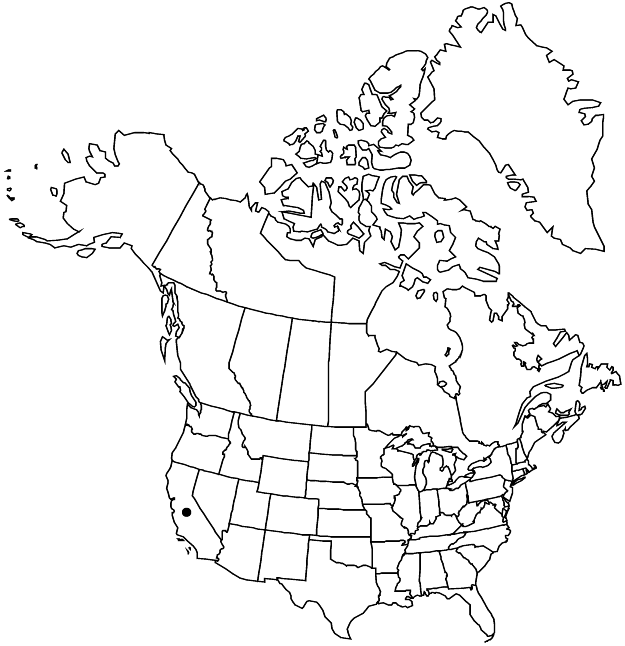Difference between revisions of "Eriogonum intrafractum"
J. Wash. Acad. Sci. 26: 305. 1936.
FNA>Volume Importer |
imported>Volume Importer |
||
| (4 intermediate revisions by one other user not shown) | |||
| Line 8: | Line 8: | ||
}} | }} | ||
|common_names=Napkinring wild buckwheat | |common_names=Napkinring wild buckwheat | ||
| + | |special_status={{Treatment/ID/Special_status | ||
| + | |code=F | ||
| + | |label=Illustrated | ||
| + | }}{{Treatment/ID/Special_status | ||
| + | |code=E | ||
| + | |label=Endemic | ||
| + | }}{{Treatment/ID/Special_status | ||
| + | |code=C | ||
| + | |label=Conservation concern | ||
| + | }} | ||
|basionyms= | |basionyms= | ||
|synonyms= | |synonyms= | ||
| Line 34: | Line 44: | ||
-->{{#Taxon: | -->{{#Taxon: | ||
name=Eriogonum intrafractum | name=Eriogonum intrafractum | ||
| − | |||
|authority=Coville & C. V. Morton | |authority=Coville & C. V. Morton | ||
|rank=species | |rank=species | ||
| Line 48: | Line 57: | ||
|publication title=J. Wash. Acad. Sci. | |publication title=J. Wash. Acad. Sci. | ||
|publication year=1936 | |publication year=1936 | ||
| − | |special status= | + | |special status=Illustrated;Endemic;Conservation concern |
| − | |source xml=https:// | + | |source xml=https://bitbucket.org/aafc-mbb/fna-data-curation/src/2e0870ddd59836b60bcf96646a41e87ea5a5943a/coarse_grained_fna_xml/V5/V5_665.xml |
|subfamily=Polygonaceae subfam. Eriogonoideae | |subfamily=Polygonaceae subfam. Eriogonoideae | ||
|genus=Eriogonum | |genus=Eriogonum | ||
Latest revision as of 22:12, 5 November 2020
Herbs, 6–15 × 0.3–0.9 dm, grayish. Aerial flowering stems 5–12 dm, disarticulating into ringlike segments 3–10(–16) mm. Leaves: petiole 3–8 cm, pilose; blade oblong-ovate, 2.5–7 × 0.7–2(–3) cm, pilose on both surfaces, margins entire. Inflorescences 1–3 × 2–6 cm; bracts scalelike distally, triangular, and 1–3 mm, semileaflike proximally, oblong, and 3–6 mm. Involucres 2.5–3.5 × 3–5 mm, pilose; teeth 0.5–2 mm. Flowers 1.5–3 mm; tepals: those of outer whorl oblanceolate, 0.9–1.2 mm wide, those of inner whorl broadly oblanceolate to fan-shaped, 1–1.5 mm wide; stamens 0.8–1.5 mm. Achenes 2–2.5 mm. 2n = 40.
Phenology: Flowering May–Oct.
Habitat: Limestone washes, slopes, and cliffs, saltbush and creosote bush communities, juniper woodlands
Elevation: (600-)800-1600 m
Discussion
Of conservation concern.
Rare and restricted to the Cottonwood, Funeral, Grapevine, and Panamint ranges of Death Valley National Park, Inyo County, Eriogonum intrafractum is one of the more remarkable species of the genus. The tall, simple, glabrous stem is branched only near the top, and then with only two to five inflorescence branches. The small leaves are restricted to the base of the plant. The lower part of the stem, when dried, fragments into napkinring-like segments. The rings have no evident value to the species, as they are not capable of vegetative reproduction. Some parenchyma cells at the fracture points are large enough to be seen with the naked eye, and it is likely that they act as compression points. Much as the intervertebral disks in the vertebral column provide a degree of flexibility, so too may these large parenchyma cells allow the top-heavy flowering stem to move in the wind without breaking. The flowers are numerous, each involucre so filled with more than a hundred flowers that it is torn apart by late anthesis.
Selected References
None.

